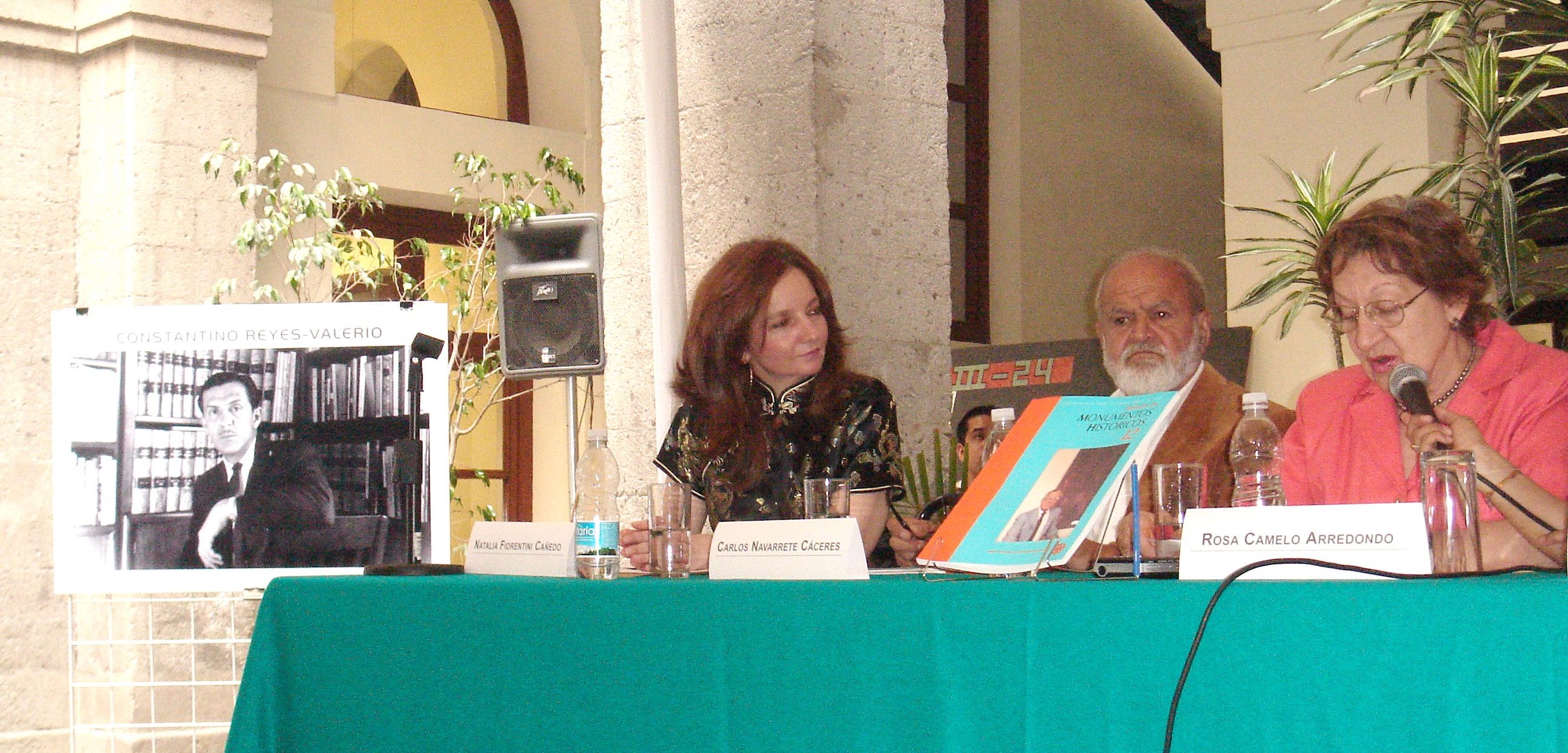|
Indocristiano
Indochristian art ( es, arte indocristiano), is a type of Latin American art that combines European colonial influences with Indigenous artistic styles and traditions. During the Spanish colonization of the Americas, Franciscan, Dominican, and Augustinian monks extensively converted indigenous peoples to Christianity, introducing them to European arts and aesthetics. The arts of this period reflect a fusion of European and indigenous religious beliefs, aesthetics, and artistic traditions. The term Indochristian art was coined by Constantino Reyes-Valerio, a scholar of pre-Columbian Mesoamerican culture and arts, in his book, ''Indochristian Art, Sculpture and Painting of 16th Century Mexico''. Reyes-Valerio's work focused on the painting and sculpture of churches and monasteries in New Spain, but had broader implications for the analysis of art throughout Latin America. Origins of the term Coinage of term ''Indochristian Art'' The term ''indochristian art'' was coined by ... [...More Info...] [...Related Items...] OR: [Wikipedia] [Google] [Baidu] |
Constantino Reyes-Valerio
Constantino Reyes-Valerio (10 January 1922 - 13 December 2006) was a prominent Mexican scholar of pre-Columbian Mesoamerican cultures, particularly the Aztec and the Maya as well as the Colonial Art. Reyes-Valerio identified the artistic contribution of Native Mexican Indians in the Colonial painting and sculpture; he coined the term Indochristian art. Another major contribution was his seminal work on the chemical composition and process of the Maya Blue Pigment where he re-discovered the technique used by the Maya to create the famous turquoise blue pigment. He was granted a Guggenheim Fellowship in 1972 for Fine Arts Research. He corresponded extensively with major scholars in Mexico and abroad such as George Kubler, Santiago Sebastian and Enrique Marco Dorta among others. In 2000 he was named Emeritus Researcher by the Instituto Nacional de Antropología e Historia. In April 2009, a special edition of the INAH bulletin (Boletin de Monumentos Historicos Num 12 enero-abri ... [...More Info...] [...Related Items...] OR: [Wikipedia] [Google] [Baidu] |
Ángel Arcabucero
An (arquebusier angel) is an angel depicted with an arquebus (an early muzzle-loaded firearm) instead of the sword traditional for martial angels, dressed in clothing inspired by that of the Andean nobles and aristocrats.Walshamp. 27/ref> The style arose in Peru in the second half of 17th century and was especially prevalent in the Cusco School. In his work ''Ángeles apócrifos de la América Virreinal'' (1992), Ramón Mujica Pinilla noted the link between ''ángeles arcabuceros'' and certain winged warriors from the pre-Hispanic pantheon. The good reception that these works found among indigenous people of the era may be due in part to the ease with which they could identify these winged warriors with their ancient gods and heroes. According to Kelly Donahue-Wallace, the genre probably originated in the Collao region, near Lake Titicaca, and were actually based on Spanish and Dutch engravings. Some of these European prints depicted apocryphal archangels, condemned by the Churc ... [...More Info...] [...Related Items...] OR: [Wikipedia] [Google] [Baidu] |
Christian Art
Christian art is sacred art which uses subjects, themes, and imagery from Christianity. Most Christian groups use or have used art to some extent, including early Christian art and architecture and Christian media. Images of Jesus and narrative scenes from the Life of Christ are the most common subjects, and scenes from the Old Testament play a part in the art of most denominations. Images of the Virgin Mary and saints are much rarer in Protestant art than that of Roman Catholicism and Eastern Orthodoxy. Christianity makes far wider use of images than related religions, in which figurative representations are forbidden, such as Islam and Judaism. However, there are some that have promoted aniconism in Christianity, and there have been periods of iconoclasm within Christianity, though this is not a common interpretation of Christian theology. History Beginnings Early Christian art survives from dates near the origins of Christianity, although many early Christians associat ... [...More Info...] [...Related Items...] OR: [Wikipedia] [Google] [Baidu] |
Nahui Ollin
Nahui Ollin is a concept in Aztec/Mexica cosmology with a variety of meanings. Nahui translates to "four" and Ollin translates to "movement" or "motion." Ollin was primarily portrayed in Aztec codices as two interlaced lines which are each portrayed with two central ends. Nahui Ollin has been used as an educational framework, particularly in social justice and ethnic studies institutions. Philosophy The concept is also described as alluding to the four preceding suns or ages in history. Nahui Ollin has been described as the fifth sun over our current world. Nahui Ollin has been described as "the sun (Tōnatiuh) in its four movements." When the fourth sun ended, Nahui Ollin emerged "from the remnant matter of an earlier age of humanity." It is believed that Quetzalcoatl traveled to Mictlān (underworld or land of the dead) to gather bones from the previous age and initiate a process of re-birthing humanity after its previous catastrophic end. According to sources describing Azte ... [...More Info...] [...Related Items...] OR: [Wikipedia] [Google] [Baidu] |
Jadeite
Jadeite is a pyroxene mineral with composition sodium, Naaluminium, Alsilicon, Si2oxygen, O6. It is hard (Mohs hardness of about 6.5 to 7.0), very tough, and dense, with a specific gravity of about 3.4. It is found in a wide range of colors, but is most often found in shades of green or white. Jadeite is formed only in subduction zones on continental margins, where rock undergoes metamorphism at high pressure but relatively low temperature. Jadeite is the principal mineral making up the most valuable form of jade, a precious stone particularly prized in China. Most gem-quality jadeite jade comes from northern Myanmar. Jade tools and implements have been found at Stone Age sites, showing that the mineral has been prized by humans since before the beginning of written history. Name The name ''jadeite'' is derived (via french: jade and la, ilia) from the Spanish language, Spanish phrase "piedra de ijada" which means "stone of the side". The Latin version of the name, ''lapis neph ... [...More Info...] [...Related Items...] OR: [Wikipedia] [Google] [Baidu] |
Metztli
In Aztec mythology, Mētztli (; also rendered Meztli, Metzi, literally "Moon") was a lunar deity, god or goddess of the moon, the night, and farmers. They were likely the same deity as Yohaulticetl or Coyolxauhqui and the male moon god Tecciztecatl; like the latter, who feared the Sun because of its fire. Legend The Moon and Sun were at one time equally bright. Fearing the earth would burn under the light of two luminaries, one of the gods threw a rabbit in the face of the other, and the one struck darkened to become today's Moon. Henceforth it is possible to distinguish a figure of a rabbit on the Moon's surface. During a full moon, the "Moon rabbit, Rabbit in the Moon" becomes readily visible. Otomi mythology For the Otomi people, Zäna was the Moon, the Queen of the Night, probably the main deity. They called her the Young Mother, who represented both Moon and Earth simultaneously. Her spouse, the Old Father, was the god of fire. The Otomi counted lunar months as a period ... [...More Info...] [...Related Items...] OR: [Wikipedia] [Google] [Baidu] |
Aureole
An aureola or aureole (diminutive of Latin ''aurea'', "golden") is the radiance of luminous cloud which, in paintings of sacred personages, surrounds the whole figure. In Romance languages, the noun Aureola is usually more related to the disc of light surrounding the head of sacred figures and that in English is called Halo or Nimbus. In art In the earliest periods of Christian art it was confined to the figures of the persons of the Christian Godhead, but it was afterwards extended to the Virgin Mary and to several of the saints. The aureola, when enveloping the whole body, generally appears oval or elliptical in form, but occasionally depicted as circular, vesica piscis, or quatrefoil. When it appears merely as a luminous disk round the head, it is called specifically a ''halo'' or ''nimbus'', while the combination of nimbus and aureole is called a '' glory''. The strict distinction between nimbus and aureole is not commonly maintained, and the latter term is most freq ... [...More Info...] [...Related Items...] OR: [Wikipedia] [Google] [Baidu] |
Our Lady Of Guadalupe
Our Lady of Guadalupe ( es, Nuestra Señora de Guadalupe), also known as the Virgin of Guadalupe ( es, Virgen de Guadalupe), is a Catholic title of Mary, mother of Jesus associated with a series of five Marian apparitions, which are believed to have occurred in December 1531, and a venerated image on a cloak enshrined within the Basilica of Our Lady of Guadalupe in Mexico City. The basilica is the most-visited Catholic shrine in the world, and the world's third most-visited sacred site. Pope Leo XIII granted the image a decree of canonical coronation on 8 February 1887 and was pontifically crowned on 12 October 1895. Description of Marian apparitions According to ''Nican Mopohua'', a 17th-century account written in the native Nahuatl language, the Virgin Mary appeared four times to Juan Diego, an indigenous Mexican peasant Chichimec and once to his uncle, Juan Bernardino. The first apparition occurred on the morning of Saturday, 9 December 1531 (Julian calendar, which is De ... [...More Info...] [...Related Items...] OR: [Wikipedia] [Google] [Baidu] |
Sor María Juana De Señor San Rafael Y Martínez
Sor may refer to: * Fernando Sor (1778–1839), Spanish guitarist and composer * Sor, Ariège, a French commune * SOR Libchavy, a Czech bus manufacturer * Sor, Azerbaijan, a village * Sor, Senegal, an offshore island * Sor River, a river in the Oromio region, Ethiopia * Sor Mañón (also known as ''Sor River''), any of a number of rivers in Galicia, Spain * Sör, a word for beer in Hungary SOR may stand for: * Shades of Rhythm, a British based rave music group * SOR Libchavy, Czech bus manufacturer * Sean O'Rourke, Irish broadcaster and journalist * Southern Ontario Railway, a shortline railway in southern Ontario * School of Rock, 2003 film starring Jack Black * Son of Rambow, 2008 film starring Bill Milner and Will Poulter * Sex offender registry * Smart order routing, a rule-based mechanism for selecting the destination of trading orders * Society of Radiographers, a UK trade union * Starfire Optical Range * Steam to oil ratio, the ratio of water used for steam and oil in o ... [...More Info...] [...Related Items...] OR: [Wikipedia] [Google] [Baidu] |
Franciscans
, image = FrancescoCoA PioM.svg , image_size = 200px , caption = A cross, Christ's arm and Saint Francis's arm, a universal symbol of the Franciscans , abbreviation = OFM , predecessor = , merged = , formation = , founder = Francis of Assisi , founding_location = , extinction = , merger = , type = Mendicant Order of Pontifical Right for men , status = , purpose = , headquarters = Via S. Maria Mediatrice 25, 00165 Rome, Italy , location = , coords = , region = , services = , membership = 12,476 members (8,512 priests) as of 2020 , language = , sec_gen = , leader_title = Motto , leader_name = ''Pax et bonum'' ''Peace and llgood'' , leader_title2 = Minister General , leader_name2 = ... [...More Info...] [...Related Items...] OR: [Wikipedia] [Google] [Baidu] |









